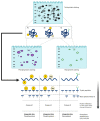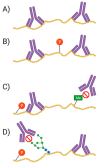Proteomes Are of Proteoforms: Embracing the Complexity
- PMID: 34564541
- PMCID: PMC8482110
- DOI: 10.3390/proteomes9030038
Proteomes Are of Proteoforms: Embracing the Complexity
Abstract
Proteomes are complex-much more so than genomes or transcriptomes. Thus, simplifying their analysis does not simplify the issue. Proteomes are of proteoforms, not canonical proteins. While having a catalogue of amino acid sequences provides invaluable information, this is the Proteome-lite. To dissect biological mechanisms and identify critical biomarkers/drug targets, we must assess the myriad of proteoforms that arise at any point before, after, and between translation and transcription (e.g., isoforms, splice variants, and post-translational modifications [PTM]), as well as newly defined species. There are numerous analytical methods currently used to address proteome depth and here we critically evaluate these in terms of the current 'state-of-the-field'. We thus discuss both pros and cons of available approaches and where improvements or refinements are needed to quantitatively characterize proteomes. To enable a next-generation approach, we suggest that advances lie in transdisciplinarity via integration of current proteomic methods to yield a unified discipline that capitalizes on the strongest qualities of each. Such a necessary (if not revolutionary) shift cannot be accomplished by a continued primary focus on proteo-genomics/-transcriptomics. We must embrace the complexity. Yes, these are the hard questions, and this will not be easy…but where is the fun in easy?
Keywords: Western blotting; bottom-up; immunoassay; mass spectrometry; proteomics; top-down; two-dimensional gel electrophoresis.
Conflict of interest statement
The authors declare no conflict of interest.
Figures









Similar articles
-
Proteomics-The State of the Field: The Definition and Analysis of Proteomes Should Be Based in Reality, Not Convenience.Proteomes. 2024 Apr 19;12(2):14. doi: 10.3390/proteomes12020014. Proteomes. 2024. PMID: 38651373 Free PMC article.
-
2DE: the phoenix of proteomics.J Proteomics. 2014 Jun 2;104:140-50. doi: 10.1016/j.jprot.2014.03.035. Epub 2014 Apr 3. J Proteomics. 2014. PMID: 24704856 Review.
-
Protein "purity," proteoforms, and the albuminome: critical observations on proteome and systems complexity.Front Cell Dev Biol. 2024 Dec 10;12:1504098. doi: 10.3389/fcell.2024.1504098. eCollection 2024. Front Cell Dev Biol. 2024. PMID: 39720005 Free PMC article.
-
Innovating the Concept and Practice of Two-Dimensional Gel Electrophoresis in the Analysis of Proteomes at the Proteoform Level.Proteomes. 2019 Oct 30;7(4):36. doi: 10.3390/proteomes7040036. Proteomes. 2019. PMID: 31671630 Free PMC article. Review.
-
Proteomics Is Analytical Chemistry: Fitness-for-Purpose in the Application of Top-Down and Bottom-Up Analyses.Proteomes. 2015 Dec 3;3(4):440-453. doi: 10.3390/proteomes3040440. Proteomes. 2015. PMID: 28248279 Free PMC article.
Cited by
-
Top-down proteomics.Nat Rev Methods Primers. 2024;4(1):38. doi: 10.1038/s43586-024-00318-2. Epub 2024 Jun 13. Nat Rev Methods Primers. 2024. PMID: 39006170 Free PMC article.
-
Proteomic Approaches to Unravel the Molecular Dynamics of Early Pregnancy in Farm Animals: An In-Depth Review.J Dev Biol. 2023 Dec 30;12(1):2. doi: 10.3390/jdb12010002. J Dev Biol. 2023. PMID: 38248867 Free PMC article. Review.
-
Two-CyDye-Based 2D-DIGE Analysis of Aged Human Muscle Biopsy Specimens.Methods Mol Biol. 2023;2596:265-289. doi: 10.1007/978-1-0716-2831-7_19. Methods Mol Biol. 2023. PMID: 36378445
-
[The new age of neurodegenerative diseases. The basis of the new approaches].Rev Neurol. 2023 Dec 1;77(11):277-281. doi: 10.33588/rn.7711.2023290. Rev Neurol. 2023. PMID: 38010785 Free PMC article. Review. Spanish.
-
Full-length single-molecule protein fingerprinting.Nat Nanotechnol. 2024 May;19(5):652-659. doi: 10.1038/s41565-023-01598-7. Epub 2024 Feb 13. Nat Nanotechnol. 2024. PMID: 38351230
References
-
- Wilkins M.R., Sanchez J.-C., Gooley A.A., Appel R.D., Humphery-Smith I., Hochstrasser D.F., Williams K.L. Progress with proteome projects: Why all proteins expressed by a genome should be identified and how to do it. Biotechnol. Genet. Eng. Rev. 1996;13:19–50. doi: 10.1080/02648725.1996.10647923. - DOI - PubMed
-
- Duncan M.W., Yergey A.L., Gale P.J., Kate Y. Quantifying proteins by mass spectrometry. LC-GC N. Am. 2014;32:726–735.
Publication types
Grants and funding
LinkOut - more resources
Full Text Sources
Miscellaneous

